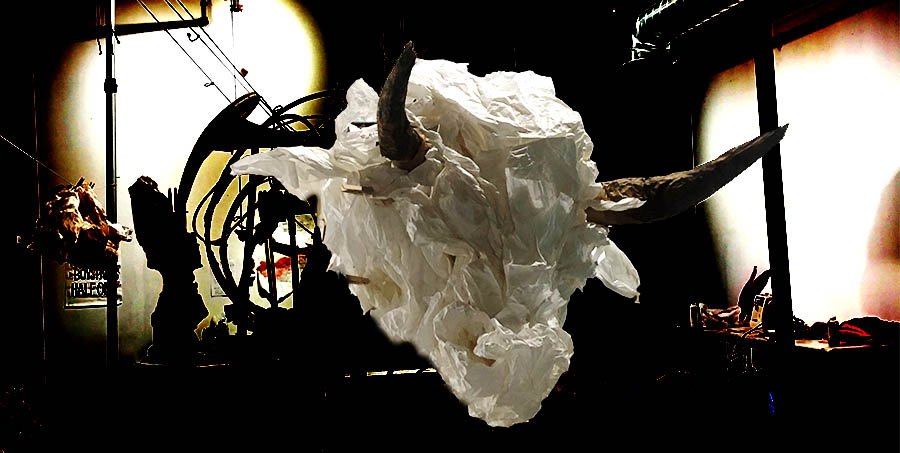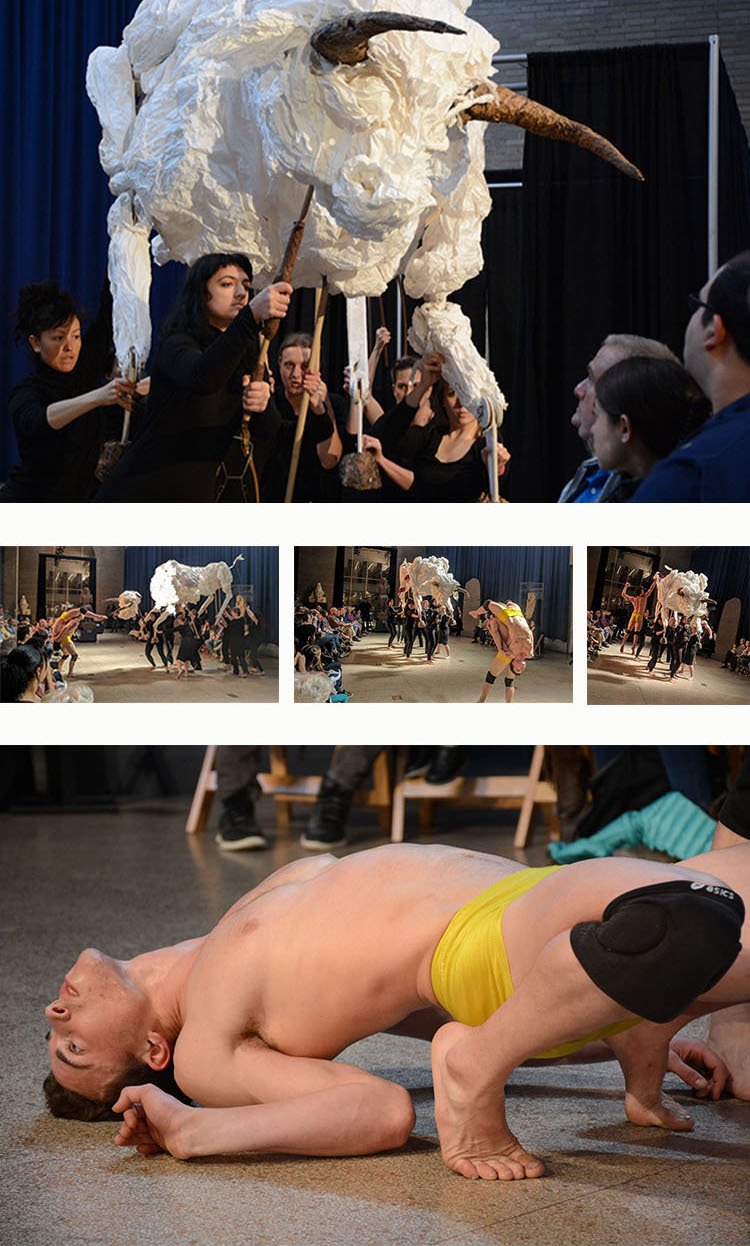Artistic Director / Creator / Designer / Lead Fabricator
Gilgamesh: In Development
Video
History / Description
The University of Pennsylvania Museum of Anthropology and Archaeology (The Penn Museum) commissioned White Box Theatre to make a multi-disciplinary performance of the Epic of Gilgamesh to premiere in September of 2019 in Harrison Theater. Six weeks into the process, we shared the early part of our exploration including puppetry, dance, and music as part of a weekend-long celebration of the opening of the Middle East Galleries.
The development process includes: reading, discussing, making objects, experimenting with movement, and curating those components into visual poetry. We worked with seasoned White Box studio-makers and new volunteers. For the first part of the project, we were in-residence with Philadelphia mosaicist, sculptor, and painter, Isaiah Zagar in his tremendous South Philadelphia studio. We also spent two days in-residence at Delaware State University experimenting with building and performance techniques with 11 students in Heather Ossandon’s Sculpture class.
-
Story Summary- The Epic of Gilgamesh
The Epic of Gilgamesh seduces with the scents of orange groves and dates, the feathers of exotic birds, the wet rivers of the Tigris and Euphrates, the taste of milk, and visions of barley and lapis lazuli. It offers the order and safety of the city-state, and the wilderness – with thickets of despair and uncertainty. It invites us learn to about the crescent of land between the two rivers where agriculture and civilization sprouted quickly. It reveals something about friendship, nature, and how we make meaning.
The story of Gilgamesh appears to be from 2100 BC. It is the earliest story known to be written down. It is recorded in cuneiform on clay tablets. The oldest of these tablets were found in Mesopotamia.
Gilgamesh was the king of Uruk. He was a formidable king–he built a 6-mile wall around the city to protect the people. He was a decent warrior and had other good qualities, but he also took advantage of the “rights of kings,” and would bed every woman on the day of her marriage. The people of Uruk didn’t like this. They prayed to the Gods for justice and the gods sent down a wild man of equal strength to challenge Gilgamesh–to keep him in check. This wild man, named Enkidu, came down from the heavens and lived with the wild animals until a woman, named Shamhat, seduces him and thus civilizes him.
Once Enkidu is civilized he enters the walled city of Uruk and challenges Gilgamesh. They have a long wrestling match which neither wins. The equality in strength ends in a mutual respect and friendship and they go out into the world to test their strength. Their friendship develops as they travel across mysterious and beautiful landscapes, sharing dreams and visions.
Like many young men, they decide to take huge risks and commit transgressions to prove their strength. They start by killing Humbaba, the protector of the Sacred Cedar Forest. They also cut down the trees of the forest. Most of the gods are not happy, except the goddess Ishtar who becomes smitten with Gilgamesh and asks Gilgamesh to marry her. Gilgamesh says, “I would do anything for you but marry you. I know how you are. You find your obsessions, put them/us on a pedestal, and then we become your slaves.” Ishtar is enraged. She threatens to punish everyone for the rejection by having the dead walk the earth. To appease her, her father agrees to send down the Bull of Heaven to destroy Gilgamesh and Enkidu. Against all odds, Gilgamesh and Enkidu slay the bull. Now all of natural order is turned on its head. The men have destroyed the Sacred Cedar Forest, and its protector, and the Bull of Heaven. The gods come together and decide that one will die an inglorious death, not in battle, but of a humbling, disfiguring disease, and the other will be left alone, to dream in sorrow. And Enkidu dies.
In the second half of the story, Gilgamesh has to come to terms with loneliness and mortality.
Reflections
**Sebastienne to include short bit of subcopy here about purpose of reflections
Collaborators
Artistic Director/Creator/Designer/Lead Fabricator: Sebastienne Mundheim
Assistant Director/Co-Creator/Lead Fabricator: Melissa MacNair
Music Composition/Performance: John B Hedges
Harp/Vocals: Kitty Jauregui
Choreography (Wrestling Sequence): Brian Sanders
Lighting Design: Troy Martin O’Shia
Performers/Devisers: Avi Wolf Boroucheff, Patricia Dominguez, Teddy Fatscher, Isabella Fehlandt, Grayce Hoffman, Niall Kaplowitz, Melissa MacNair, Alec Miller, Kittson O’Neill, Claris Park, Jane Winkel
Dramaturgical Consultant/Workshop Collaborator: Marcia Ferguson
Conceptual Contributors: Kittson O’Neill, Brian Sanders
Administrative Coordinator: Noelle McManus
Tech Support: Jeremy Cohen
Photo Credits: Sebastienne Mundheim, Thomas Stanley, Eun Jung Choi, Stephen Shuster, Noelle McManus, Jeremy Hugo
Studio Makers and Workshop Participants: Anna DeCaria, Qimmah Muhammed, Justin Davis, Maria Carroll, Paige Whitman, Heather Ossandon, Heather Ossandon’s sculpture class at Delaware State University, Stephen Shuster, Nicole McCourt, Jeanette Brown, Jen Bermel, Leah Coonan, Jeremy Hugo, Taiwo Sokan, Morriah Young, David Caler, Ethan Gurney, Martin Lautz
Special Thanks: Steve Tinney, Eric Baratta, Kate Quinn, Tena Thomason, Arielle Brown, Isaiah Zagar, Tom Miles, Conor Corcoran, Jennifer Snead, The Philadelphia Cultural Fund, The Lenfest Foundation, The Penn Theatre Department, and The Penn Museum.




